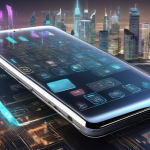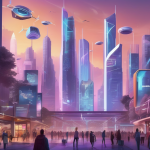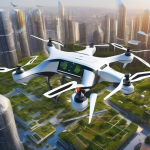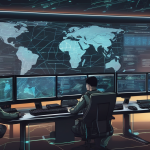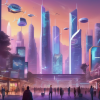The First Novel Written by AI: Where Technology Meets Art

Imagine a world where machines not only assist us but also create art that resonates with our emotions. The advent of artificial intelligence (AI) in literature marks a significant turning point in the way we perceive creativity. This article explores the groundbreaking intersection of AI and literature, examining how technology is reshaping creative writing and what this means for the future of storytelling. From the first algorithms that could barely string two sentences together to the sophisticated systems we have today, AI’s journey in literature is nothing short of fascinating.
As we delve deeper into this topic, it’s essential to recognize that AI does not merely mimic human creativity; it enhances it. Picture an artist working alongside a machine, where the artist provides inspiration and the AI generates possibilities they might never have considered. This partnership can lead to innovative narratives, pushing the boundaries of traditional storytelling. The implications are vast, and as we explore the processes and outcomes of AI-generated novels, we begin to understand the potential future impacts on both writers and readers alike.
Furthermore, the integration of AI in literature prompts us to question the very nature of creativity. Can a machine truly understand human emotions, or does it merely replicate patterns it has learned from vast datasets? This article will also address the challenges and limitations that come with this technology, including issues of originality and emotional depth. In a world increasingly influenced by AI, one must wonder: how will these advancements redefine what it means to be an author?
Join us as we explore this captivating journey where technology meets art, revealing the intricate dance between human creativity and artificial intelligence. Together, we will uncover the future of storytelling in a world where machines can craft narratives that challenge our perceptions and ignite our imaginations.
The Evolution of AI in Literature
The journey of artificial intelligence in literature is nothing short of remarkable. It all started with basic algorithms that could barely string together a coherent sentence. However, as technology advanced, so did the capabilities of AI. Today, we find ourselves at a fascinating crossroads where machines can create entire narratives that captivate readers. Can you imagine a world where a computer writes a novel that rivals the works of human authors? This is not just a dream; it’s becoming a reality.
One of the key milestones in this evolution was the development of Natural Language Processing (NLP). This technology allows machines to understand and generate human-like text, which is essential for storytelling. Think of NLP as the translator between human creativity and machine logic. It enables AI to grasp the nuances of language, the rhythm of prose, and even the emotional undertones that make literature so compelling.
As we delve deeper into the timeline of AI in literature, we can highlight several significant advancements:
- Early Algorithms: Simple programs that could generate poetry or short stories based on predefined rules.
- Machine Learning: The introduction of machine learning algorithms that learned from vast datasets, allowing for more nuanced and complex narratives.
- Deep Learning: The use of neural networks to analyze and mimic writing styles, leading to the creation of longer, more sophisticated works.
These milestones have paved the way for AI to not only assist in writing but also to challenge our perceptions of creativity itself. As we witness the ongoing evolution of AI in literature, one can’t help but wonder: what does the future hold for storytelling when machines become co-authors?
The Process of AI Novel Creation
The creation of a novel by artificial intelligence is nothing short of a fascinating journey through the realms of technology and imagination. It all starts with intricate algorithms that serve as the backbone of AI storytelling. These algorithms are designed to analyze vast amounts of text, learning from existing literature to generate new narratives that can surprise and engage readers. Imagine a chef who meticulously studies recipes from around the world, only to create a unique dish that blends flavors in unexpected ways—that’s how AI crafts its stories.
At the heart of this process lies Natural Language Processing (NLP), a crucial element that enables machines to understand and produce human-like text. NLP is what allows AI to grasp the nuances of language, including idioms, metaphors, and emotional undertones. It’s like teaching a robot to not just speak but to feel the rhythm of a poem or the tension of a thriller. By employing NLP, AI can create narratives that resonate with readers on a deeper level.
Furthermore, machine learning algorithms play a pivotal role in shaping these narratives. By analyzing patterns and styles from a multitude of texts, AI learns what makes a story compelling. Consider this: if you were to read thousands of novels, you’d start to notice recurring themes, character arcs, and plot structures. AI does the same, and it uses this knowledge to weave together intricate tales that can captivate a diverse audience.
However, the quality of the output heavily depends on the data sources used for training the AI. The richness of the literature it consumes shapes its understanding of narrative structures. For instance, if an AI is trained primarily on classic literature, it may struggle to replicate the fast-paced dialogue of contemporary fiction. Therefore, a diverse range of literary sources is essential for developing a well-rounded AI storyteller.
In essence, the process of AI novel creation is a blend of technology and creativity, where algorithms learn, adapt, and ultimately produce stories that challenge our perceptions of authorship. As we continue to explore this intersection of technology and art, the potential for innovation in storytelling becomes limitless.
Natural Language Processing, or NLP, is a fascinating field that lies at the heart of AI’s ability to create literature. Imagine teaching a machine to understand the nuances of human language, including the subtleties of tone, context, and emotion. That’s exactly what NLP aims to achieve! By breaking down language into manageable components, NLP allows AI to not only generate text but also to comprehend it in a way that mimics human understanding.
At its core, NLP involves several key processes that enable machines to process and analyze large amounts of textual data. These processes include:
- Tokenization: This is the first step where sentences are broken down into individual words or phrases, making it easier for the AI to analyze.
- Parsing: Here, the AI examines the grammatical structure of sentences, identifying subjects, verbs, and objects to understand relationships between words.
- Sentiment Analysis: This process allows the AI to gauge emotions in text, helping it to create narratives that resonate with readers on an emotional level.
By utilizing these techniques, AI can craft stories that are not just coherent but also engaging. For instance, when an AI is trained on a diverse dataset that includes classic literature, modern prose, and even poetry, it learns to identify various writing styles and genres. This knowledge empowers the AI to generate narratives that are rich and varied, often surprising readers with its creativity.
Moreover, advancements in NLP are continuously evolving. With each update, AI systems become more adept at understanding context, idioms, and even cultural references. This means that the gap between human and machine-generated text is narrowing, making it increasingly difficult to distinguish between the two. As we move forward, the role of NLP in AI literature will undoubtedly expand, leading to even more sophisticated storytelling capabilities.
The Role of Machine Learning
Machine learning is the backbone of AI’s ability to generate compelling narratives. Imagine teaching a child to write by showing them countless stories; similarly, machine learning algorithms analyze vast amounts of text data to learn patterns, styles, and structures inherent in literature. This process is not just about rote memorization; it’s akin to a chef experimenting with different ingredients to create a unique dish. Each algorithm acts as a chef, mixing and matching elements of storytelling to craft something new and exciting.
At its core, machine learning utilizes techniques that allow AI to improve its writing capabilities over time. The algorithms can identify common themes, character arcs, and even emotional undertones present in various texts. This ability to learn from existing literature enables AI to mimic human-like creativity, making the narratives it generates more engaging and relatable. For instance, when an AI model is trained on classic novels, it absorbs the nuances of language, character development, and plot progression, which it can then apply in its own storytelling.
Moreover, machine learning allows for the personalization of content. By analyzing reader preferences and feedback, AI can adapt its writing style to cater to specific audiences. This is much like how a musician might change their sound to resonate with different fans. The potential for tailored storytelling opens up exciting possibilities for authors and readers alike, creating a more interactive literary experience.
However, the journey isn’t without its hurdles. While machine learning enhances creativity, it also poses questions about the authenticity of AI-generated content. As algorithms become more sophisticated, the line between human and machine-generated narratives blurs. This evolution raises important discussions about what it means to be a storyteller in the age of AI.
Data Sources for AI Training
When it comes to training AI for novel writing, the quality of data is paramount. Imagine trying to build a house with subpar materials; the end result would be shaky at best. Similarly, AI models rely on a diverse range of text sources to develop their storytelling abilities. These sources can include everything from classic literature to modern novels, articles, and even online content. The broader the data pool, the more nuanced the AI’s understanding of language and narrative becomes.
One of the most fascinating aspects of AI training is the variety of genres it can pull from. For instance, consider the following types of data sources:
- Classic Literature: Works by authors like Shakespeare and Dickens provide rich language and complex characters.
- Modern Novels: Contemporary works introduce current slang, themes, and storytelling techniques.
- Poetry: The rhythmic and metaphorical nature of poetry helps AI understand emotional depth.
- Online Articles: News and blogs offer concise, engaging writing styles that resonate with today’s readers.
Moreover, the training process involves not just feeding data to the AI but also fine-tuning its algorithms to recognize patterns and styles. For instance, machine learning techniques analyze how different authors construct their narratives. This means that the AI learns not just the words but the emotional beats and character arcs that make stories compelling.
In essence, the diversity and richness of the data sources directly influence the AI’s ability to generate high-quality narratives. As technology advances, the incorporation of even more varied data will likely enhance AI’s storytelling capabilities, blurring the lines between human and machine-generated literature.
The Creative Collaboration Between Humans and AI
The world of storytelling is undergoing a fascinating transformation, where the creative collaboration between humans and AI is becoming increasingly prevalent. Imagine a scenario where a writer sits at their desk, not alone, but alongside an intelligent machine that can generate ideas, suggest plot twists, and even help flesh out characters. This partnership is not about replacing the human touch; rather, it enhances the creative process, allowing authors to explore new realms of storytelling they might not have considered before.
One of the most exciting aspects of this collaboration is the ability to merge human intuition with machine efficiency. While a human author brings emotional depth and personal experiences to their writing, an AI can analyze vast amounts of data to identify trends, themes, and styles that resonate with readers. This synergy allows for the creation of narratives that are not only engaging but also tailored to audience preferences.
Consider the following benefits of collaborating with AI:
- Idea Generation: AI can assist in brainstorming sessions, providing unique plot ideas and character concepts that a writer might not have come up with on their own.
- Editing and Refinement: AI tools can help streamline the editing process, offering suggestions for improving sentence structure, grammar, and even pacing.
- Research Assistance: AI can quickly gather and summarize information on various topics, saving authors precious time during the writing process.
However, it’s essential to remember that the human element remains irreplaceable. The nuances of human emotion, cultural context, and personal storytelling are what breathe life into a narrative. AI may provide the framework, but it is the human author who adds the color and vibrancy that captivates readers. This partnership opens up a world of possibilities, where writers can push the boundaries of their creativity with the help of cutting-edge technology.
As we look to the future, the potential for this creative collaboration is immense. Authors who embrace AI as a co-creator will find themselves not just telling stories but crafting immersive experiences that resonate on multiple levels. The journey ahead is not just about technology; it’s about reimagining the very essence of storytelling itself.
Challenges and Limitations of AI in Writing
As we venture deeper into the world of AI-generated literature, it’s essential to acknowledge the challenges and limitations that accompany this technological marvel. Despite the impressive capabilities of AI, it still grapples with several issues that can hinder its effectiveness in creative writing. One of the most significant hurdles is the question of originality. While AI can produce text that mimics human writing styles, it often lacks the unique voice and perspective that come from genuine human experience. This raises eyebrows about whether AI-generated content can truly be considered art.
Additionally, the emotional depth that characterizes compelling storytelling is another area where AI struggles. While algorithms can analyze patterns in text, they often miss the nuances of human emotions and the subtleties of human relationships. Imagine trying to capture the essence of love or loss without having experienced it firsthand; that’s the challenge AI faces. This limitation can lead to narratives that feel flat or lack the emotional resonance that readers crave.
Moreover, ethical considerations loom large in the realm of AI writing. As machines churn out novels, the question of copyright and ownership becomes increasingly complex. Who owns the rights to a story created by an AI? Is it the programmer, the user, or the AI itself? These questions are not just theoretical; they have real implications for authors and the publishing industry as a whole.
In terms of quality, while AI can generate vast quantities of text at lightning speed, the literary merit of such works can vary significantly. A recent study highlighted that, although AI can produce 1,000 pages of text in a fraction of the time it takes a human author to write a single book, the quality of that output can be questionable. This raises an important dilemma: is it better to have a few well-crafted stories or a flood of mediocre ones?
In summary, while AI presents exciting possibilities for the future of literature, it is crucial to remain aware of its challenges and limitations. As we navigate this uncharted territory, the collaboration between human creativity and artificial intelligence will be vital in overcoming these obstacles.
Issues of Copyright and Ownership
The emergence of AI-generated literature has sparked a heated debate about copyright and ownership. As machines begin to create stories, the question arises: who owns the rights to these works? Is it the programmer who developed the AI, the company that owns the AI, or the AI itself? This complex web of ownership can be likened to a modern-day copyright conundrum, where traditional laws struggle to keep pace with technological advancements.
One significant issue is that current copyright laws are primarily designed for human authors. They protect the expression of ideas but do not explicitly cover works generated by machines. This creates a gray area where AI-generated content may not be eligible for copyright protection, leaving authors and developers in a precarious position. For instance, if an AI writes a bestselling novel, can the creator of the AI claim any rights to the profits? Or does the credit go solely to the AI, which, as a non-human entity, cannot hold copyright?
Moreover, the potential for plagiarism increases when AI uses existing texts as training data. If an AI model generates a story that closely resembles an existing work, it raises questions about originality. This could lead to legal disputes where human authors might claim that their original ideas have been infringed upon by AI-generated content. The ethical implications are profound, as the lines between inspiration and imitation blur.
To navigate these murky waters, some experts suggest the need for new legislation that specifically addresses the rights associated with AI-generated works. This could include establishing a framework for determining ownership and providing guidelines on how AI can be used in creative contexts. As we move forward, it is crucial for lawmakers, technologists, and artists to collaborate in creating a legal landscape that protects the rights of all parties involved.
Quality vs. Quantity in AI Writing
When it comes to AI-generated literature, the debate of quality versus quantity is a hot topic. On one hand, AI can churn out pages upon pages of text in a matter of minutes, making it seem like a literary machine. Imagine a factory where words are produced as quickly as cars roll off the assembly line! But, does speed really equate to substance? This is where the conversation takes a turn.
While AI can produce vast amounts of content, the quality of that content can vary significantly. For instance, an AI may generate a novel that is technically coherent but lacks the emotional depth and intricate character development that readers crave. Think of it like a fast-food meal: it fills you up, but it doesn’t always satisfy your appetite for something truly delicious. Many readers are looking for that rich narrative that resonates on a deeper level, something that often requires a human touch.
To illustrate this point, let’s consider a few factors:
- Creativity: AI often relies on existing patterns and data, which can limit its ability to create truly original stories.
- Emotional Depth: While AI can mimic emotional language, it may struggle to convey genuine feelings that connect with readers.
- Style and Voice: Each author has a unique voice that AI struggles to replicate authentically.
As a result, while the quantity of AI-generated text can be impressive, the quality remains a critical concern. It’s essential for both AI developers and authors to find a balance. The future of AI writing may not just be about how much can be produced but rather how well it can engage and inspire readers. The challenge will be to harness the speed of AI while ensuring that the end product is not just a flood of words but a meaningful narrative that captivates the audience.
The Future of AI in Literature
The potential for AI in literature is nothing short of astonishing. As we stand on the brink of a new era, the fusion of technology and creativity is reshaping how stories are told. Imagine a world where AI not only assists writers but also inspires them, pushing the boundaries of imagination. This collaborative relationship between humans and machines is set to redefine the literary landscape.
One of the most exciting prospects is the emergence of personalized storytelling. With advancements in AI, readers may soon enjoy stories tailored to their preferences. Picture an AI that learns your interests and crafts narratives specifically for you, making reading an even more engaging experience. This shift could lead to a new genre of literature where the reader is not just a passive consumer but an active participant in the storytelling process.
Moreover, as AI continues to evolve, we can expect to see diverse narratives that reflect a broader spectrum of human experience. AI can analyze vast amounts of data from different cultures and perspectives, creating stories that resonate with a global audience. This ability to weave together various cultural threads can lead to a richer and more inclusive literary world.
However, the future of AI in literature isn’t without its challenges. As we embrace these technological advancements, we must also consider the implications for traditional publishing. The industry is already adapting to the changing landscape, with many publishers exploring how to integrate AI into their workflows. This could mean a shift in how books are marketed and sold, as AI-generated content becomes more prevalent.
In conclusion, the future of AI in literature is a thrilling frontier filled with possibilities. As technology continues to advance, we can anticipate a literary world that is more dynamic, interactive, and inclusive. The collaboration between human creativity and artificial intelligence promises to unlock new realms of storytelling, making literature an even more vibrant and multifaceted art form.

Emerging Trends in AI Literature
The landscape of literature is undergoing a remarkable transformation as artificial intelligence continues to evolve. With each passing day, new trends are emerging that are reshaping how stories are told and consumed. One of the most exciting trends is the rise of interactive storytelling. AI-generated narratives can now adapt based on reader preferences, creating a personalized reading experience that engages audiences in unprecedented ways. Imagine reading a novel where the plot twists and turns based on your choices—this is no longer just a dream but a reality in the making.
Another fascinating trend is the integration of multimedia elements into AI literature. Authors and AI systems alike are experimenting with combining text, audio, and visuals to create immersive storytelling experiences. This trend not only enriches the narrative but also caters to diverse learning styles and preferences. For example, a novel might include background music or illustrations that evolve alongside the story, making the reading experience more dynamic and engaging.
Furthermore, the use of collaborative writing platforms is gaining traction. These platforms enable authors and AI to work together in real-time, allowing human creativity to blend seamlessly with machine-generated suggestions. This collaboration can lead to innovative storytelling techniques and unique narrative structures that might not be possible through traditional writing methods. Authors can leverage AI’s analytical capabilities to refine their plots or develop complex characters, enhancing their creative output.
As we look to the future, it’s clear that the intersection of technology and creativity is not just a passing trend; it represents a fundamental shift in the literary world. The potential for AI to inspire new genres, styles, and forms of expression is immense. With ongoing advancements in natural language processing and machine learning, we can only imagine the stories that await us—stories that challenge our perceptions, engage our emotions, and redefine what it means to be a writer in the digital age.
Impact on Traditional Publishing
The emergence of AI in literature is not just a technological advancement; it’s a revolution that is shaking the foundations of traditional publishing. As AI-generated novels gain popularity, publishers are faced with a new set of challenges and opportunities that could redefine the entire industry. Imagine a world where a machine can churn out a novel in minutes, while human authors spend months or even years perfecting their craft. This disparity raises questions about the value of human creativity versus the efficiency of AI.
One significant impact is the shift in content production. Traditional publishers have long relied on a model where human authors create manuscripts that undergo rigorous editing and marketing processes. Now, with AI, the speed of production can drastically increase, leading to a potential flood of new titles. This could overwhelm readers, making it challenging for them to discern quality literature from mere quantity. In this rapidly evolving landscape, publishers might need to rethink their strategies to maintain relevance.
Additionally, AI’s ability to analyze market trends and reader preferences can provide publishers with valuable insights. By leveraging data, publishers can identify what genres or themes resonate with audiences, allowing them to tailor their offerings more effectively. However, this reliance on data-driven decisions could lead to a homogenization of content, where unique voices and experimental narratives are overshadowed by formulas designed to maximize sales.
Furthermore, the rise of AI authors presents a legal conundrum. As AI-generated works become more prevalent, questions about copyright and ownership become critical. Who owns the rights to a novel created by an AI? The author of the algorithm? The company that developed it? These questions could lead to significant legal battles and redefine what it means to be an author in the digital age.
In conclusion, while AI holds the potential to revolutionize the publishing industry, it also poses significant challenges that require careful consideration. As we stand on the brink of this new era, both traditional publishers and authors must adapt to the changing landscape, ensuring that the essence of storytelling is not lost in the process.
Frequently Asked Questions
- What is the first novel written by AI?
The first novel written by AI is a groundbreaking work that showcases the capabilities of artificial intelligence in creative writing. It represents a significant step in blending technology with literature, allowing machines to generate narratives that can captivate audiences.
- How does AI create a novel?
AI creates a novel by utilizing complex algorithms and natural language processing (NLP) techniques. These systems analyze vast amounts of text data, learning patterns and styles to generate coherent and engaging stories. It’s like teaching a child to write by showing them countless books!
- Can AI replace human authors?
No, AI cannot replace human authors. Instead, it serves as a tool that enhances human creativity. Think of it as a co-pilot in the writing process, helping authors brainstorm ideas and develop narratives, but the heart and soul of storytelling still come from human experience.
- What are the challenges of AI in writing?
AI in writing faces several challenges, including issues of originality, emotional depth, and ethical considerations. While AI can produce text quickly, ensuring that it resonates with readers on a deeper level is still a hurdle.
- How does copyright apply to AI-generated works?
The question of copyright for AI-generated works is complex. As AI creates literature, it raises legal implications regarding ownership and rights. Currently, it’s a gray area that needs further exploration as AI continues to evolve in the literary world.
